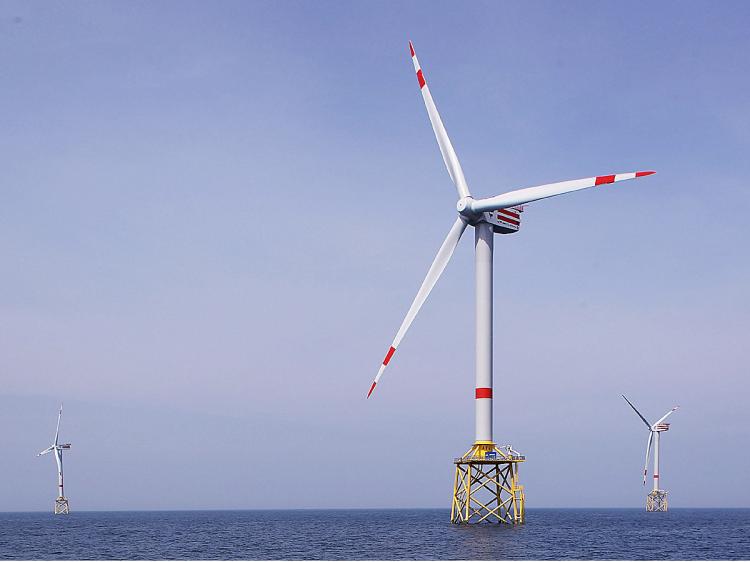The Department of the Interior and ten states created the Atlantic Offshore Wind Energy Consortium this month. When man first ventured onto the sea he could feel the potential of the wind, and he used sails to capture that power. Today is the next step to harness the wind. Department of the Interior Secretary Ken Salazar and the governors from Massachusetts, Maine, New Hampshire, Rhode Island, New York, New Jersey, Delaware, Maryland, Virginia, and North Carolina signed a Memorandum of Understanding to establish the Atlantic Offshore Wind Energy Consortium on June 8, 2010.
The objective is to promote the efficient, orderly, responsible, and coordinated development of wind resources on the Outer Continental Shelf, according to the Department of the Interior. Many other states are pursuing off-shore wind power, including South Carolina, Georgia, Florida, Texas, Ohio, and Michigan. Florida has multiple options to get wind power off their eastern, western, or southern coasts. Texas may explore Gulf of Mexico options. Michigan and Ohio are looking at the Great Lakes as their source of wind power.
Secretary Salazar announced a new regional renewable energy office, located in Virginia, to control and establish projects on the outer continental shelf. The outer continental shelf is a point on the sea floor before it falls off into extreme depth. It is still part of North America.
“I am very pleased to be joining with the governors of Atlantic coastal states to promote the safe and environmentally responsible development of the exceptional wind energy resources off our coasts. Appropriate development of Outer Continental Shelf wind power will enhance regional and national energy security and create American jobs through the development of energy markets and investments in renewable energy technologies,” said Salazar in a press release.
Many projects are already planned for the eastern coast of the United States on the Atlantic Outer Continental Shelf. The government hopes they will quickly create jobs which will last. The projects are also meant to move toward fulfilling the long unmet promise of weaning the country off oil.
Power and job creation are big benefits. Officials were also motivated by the fact that wind power is clean energy. They hope building wind plants in abundance in an area where there’s enough power to tap will reduce the need for fossil fuels. Climate change, and trying to halt it or slow it, is another reason for the innovation. With the further pursuit of clean energy comes the potential for curbing climate change. Wind energy would not emit greenhouse gases like CO2. Burning fossil plants produces C02 in abundance.
“Renewable energy resources hold great economic promise. By one estimate, if our nation fully pursues its potential for wind energy on land and offshore, wind can generate as much as 20 percent of our electricity by 2030 and create a quarter-million jobs in the process,” wrote Salazar in a statement.
This project was first introduced in February of 2010 during a meeting with Atlantic coast state governors and representatives in which Salazar said he was forming a consortium. All Atlantic coast states were invited to join. The Department of the Interior and Atlantic Coast governors will use this document to facilitate federal-state cooperation for commercial wind development. The next step is setting priorities, objectives, specific recommendations, and steps for reaching the objectives.
The Interior’s new Bureau of Ocean Management will oversee this development of wind and other renewable power, like solar, on the Outer Continental Shelf. The Interior will work with state governments and local, tribal, and federal entities to facilitate the commercial leasing process.
The United States is behind in offshore wind power generation. The U.K. and Denmark paved the way in the industry and are still leaders. Around 2,400 megawatts of off-shore wind power is produced world wide, with virtually none in the U.S.
The Department of Energy estimated wind farms could generate nearly as much power as the country now produces. Greg Watson is senior advisor to the Secretary for Clean Energy Technology, Executive Office of Energy and Environmental Affairs. He wrote in his blog, “This nation’s offshore wind energy resource is vast and inexhaustible. The U.S. Department of Energy estimates it to be roughly 900,000 megawatts—close to the country’s total installed capacity.”
The state that will get the wind power rolling is Massachusetts. It was officially selected to host the nation’s state of the art wind facility to test the next generation of wind turbine blades.
The objective is to promote the efficient, orderly, responsible, and coordinated development of wind resources on the Outer Continental Shelf, according to the Department of the Interior. Many other states are pursuing off-shore wind power, including South Carolina, Georgia, Florida, Texas, Ohio, and Michigan. Florida has multiple options to get wind power off their eastern, western, or southern coasts. Texas may explore Gulf of Mexico options. Michigan and Ohio are looking at the Great Lakes as their source of wind power.
Secretary Salazar announced a new regional renewable energy office, located in Virginia, to control and establish projects on the outer continental shelf. The outer continental shelf is a point on the sea floor before it falls off into extreme depth. It is still part of North America.
“I am very pleased to be joining with the governors of Atlantic coastal states to promote the safe and environmentally responsible development of the exceptional wind energy resources off our coasts. Appropriate development of Outer Continental Shelf wind power will enhance regional and national energy security and create American jobs through the development of energy markets and investments in renewable energy technologies,” said Salazar in a press release.
Many projects are already planned for the eastern coast of the United States on the Atlantic Outer Continental Shelf. The government hopes they will quickly create jobs which will last. The projects are also meant to move toward fulfilling the long unmet promise of weaning the country off oil.
Power and job creation are big benefits. Officials were also motivated by the fact that wind power is clean energy. They hope building wind plants in abundance in an area where there’s enough power to tap will reduce the need for fossil fuels. Climate change, and trying to halt it or slow it, is another reason for the innovation. With the further pursuit of clean energy comes the potential for curbing climate change. Wind energy would not emit greenhouse gases like CO2. Burning fossil plants produces C02 in abundance.
“Renewable energy resources hold great economic promise. By one estimate, if our nation fully pursues its potential for wind energy on land and offshore, wind can generate as much as 20 percent of our electricity by 2030 and create a quarter-million jobs in the process,” wrote Salazar in a statement.
This project was first introduced in February of 2010 during a meeting with Atlantic coast state governors and representatives in which Salazar said he was forming a consortium. All Atlantic coast states were invited to join. The Department of the Interior and Atlantic Coast governors will use this document to facilitate federal-state cooperation for commercial wind development. The next step is setting priorities, objectives, specific recommendations, and steps for reaching the objectives.
The Interior’s new Bureau of Ocean Management will oversee this development of wind and other renewable power, like solar, on the Outer Continental Shelf. The Interior will work with state governments and local, tribal, and federal entities to facilitate the commercial leasing process.
The United States is behind in offshore wind power generation. The U.K. and Denmark paved the way in the industry and are still leaders. Around 2,400 megawatts of off-shore wind power is produced world wide, with virtually none in the U.S.
The Department of Energy estimated wind farms could generate nearly as much power as the country now produces. Greg Watson is senior advisor to the Secretary for Clean Energy Technology, Executive Office of Energy and Environmental Affairs. He wrote in his blog, “This nation’s offshore wind energy resource is vast and inexhaustible. The U.S. Department of Energy estimates it to be roughly 900,000 megawatts—close to the country’s total installed capacity.”
The state that will get the wind power rolling is Massachusetts. It was officially selected to host the nation’s state of the art wind facility to test the next generation of wind turbine blades.






